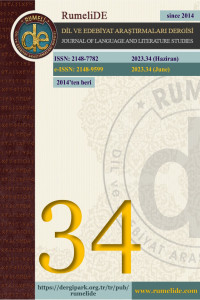Öz
Kaynakça
- Assmann, A. (2007). Geschichte im Gedächtnis. München: Verlag C.H. Beck oHG.
- Bauß, G. (1977). Die Studentenbewegung der sechziger Jahre in der Bundesrepublik und Westberlin. Köln: Pahl-Rugenstein Verlag.
- Boyer, P., Wertsch, J. V. (2009). Memory in Mind and Culture. USA: Cambridge University Press.
- Busche, J. (2003). Die 68er. Biographie einer Generation. Berlin: Berliner Taschenbuch Verlag.
- Connerton, P. (1992). How Societies Remember. USA: Cambridge University Press.
- Franke, H.P.; Staehle U.; Ulrich G.; Wenzelburger D. (1983). Geschichte der deutschen Literatur von 1945 bis zur Gegenwart. Stuttgart: Ernst Klett Verlag.
- Frei, N. (2008). 1968. Jugendrevolte und Globaler Protest. München: Deutscher Taschenbuch Verlag.
- Germer, K. (2012). Mythologisierung deutscher Geschichte. Uwe Timms narrative Asthetik. Göttingen: V&R Unipress.
- Hadem, M. (2007). Die 68er Bewegung: Eine politisch historische Auseinandersetzung. München: GRIN Verlag.
- Herbert, U. (2014). Geschichte Deutschlands im 20. Jahrhundert. München: Verlag C. H. Beck.
- Hielscher, M. (2007). Uwe Timm. München: Deutscher Taschenbuch Verlag.
- https://www.faz.net/aktuell/feuilleton/buecher/rezensionen/belletristik/uwe-timm-rot-die-gans-in-der-revolte-142052.html (date of access: 12.04.2023).
- Kurlansky, M. (2005). 1968: The Year that Rocked The World. New York: Random House Publishing Group.
- Ricceur, P. (2013). Zaman ve Anlatı: Dört Anlatılan (öykülenen zaman). Çev.: Umut Öksüzan, Atakan Altınörs. İstanbul: Yapı Kredi Yayınları.
- Rüdenauer, U. (2001). Der alte Schwung ist hin. Uwe Timm beschäftigt sich in "Rot" einmal wieder mit der 68er-Generation. https://literaturkritik.de/id/4286 (date of access: 11.03.2023).
- Schlink, B. (2012). Geçmişe İlişkin Suç ve Bugünkü Hukuk. Haz. Cemal Bali Akal. Ankara: Dost Kitabevi Yayınları.
- Shortt, L. (2015). German Narratives of Belonging Writing Generation and Place in the Twenty-First Century. USA: Modern Humanities Research Association and Routledge.
- Stamova, D. K. (2018). Melancholie in Uwe Timms Romanen Rot und Morenga. USA: phD. Dissertation, Washington University in St. Louis.
- Steinert, H. (2001). Ach, Iris, Ich Weiß Zu Viel Uwe Timm Denkt Über Rot Nach. https://www.welt.de/print-welt/article482416/Ach-Iris-ich-weiss-zu-viel-Uwe-Timm-denkt-ueber-Rot-nach.html (date of access: 28.04.2023).
- Timm, U. (2001). Rot. Köln: Verlag Kiepenheuer & Witsch.
- Weisz, S. (2009). Die 68er- Revolte im Werk von Uwe Timm. Marburg: Tectum Verlag.
Öz
Literary motifs in fiction illustrate the subject matter and aestheticize the spirit and mindset of the time described. This study examined the historical and political motifs of the 68ers' generation within the framework of memory literature in the novel "Rot" (2001) by Uwe Timm, one of the most influential second-generation writers of German literature after World War II. The historical and political motifs in the novel reflect the struggle of the youth and student movements of 1968 in particular. In addition, the motifs in the work point to the cultural background of the worldviews of the 68ers' generation, which did not experience the Second World War and its aftermaths like the previous generation. The novel focuses on the journey of Thomas Linde, a jazz commentator and funeral orator, to the past. The main character, is preparing the funeral speech of his friend with whom he protested together in 1968. The novel describes Linde's process of writing this speech and the 68ers' generation's reckoning and farewell to the past they had internalized. The novel uses modern and post-modern narrative techniques to describe the past memories of 1968 with semi-autobiographical, half-fictional elements. This study examines in the context of memory theories how and why Uwe Timm constructed the political and historical motifs of the 1968 period based on his life story as a representative of the 68ers' generation.
Anahtar Kelimeler
Kaynakça
- Assmann, A. (2007). Geschichte im Gedächtnis. München: Verlag C.H. Beck oHG.
- Bauß, G. (1977). Die Studentenbewegung der sechziger Jahre in der Bundesrepublik und Westberlin. Köln: Pahl-Rugenstein Verlag.
- Boyer, P., Wertsch, J. V. (2009). Memory in Mind and Culture. USA: Cambridge University Press.
- Busche, J. (2003). Die 68er. Biographie einer Generation. Berlin: Berliner Taschenbuch Verlag.
- Connerton, P. (1992). How Societies Remember. USA: Cambridge University Press.
- Franke, H.P.; Staehle U.; Ulrich G.; Wenzelburger D. (1983). Geschichte der deutschen Literatur von 1945 bis zur Gegenwart. Stuttgart: Ernst Klett Verlag.
- Frei, N. (2008). 1968. Jugendrevolte und Globaler Protest. München: Deutscher Taschenbuch Verlag.
- Germer, K. (2012). Mythologisierung deutscher Geschichte. Uwe Timms narrative Asthetik. Göttingen: V&R Unipress.
- Hadem, M. (2007). Die 68er Bewegung: Eine politisch historische Auseinandersetzung. München: GRIN Verlag.
- Herbert, U. (2014). Geschichte Deutschlands im 20. Jahrhundert. München: Verlag C. H. Beck.
- Hielscher, M. (2007). Uwe Timm. München: Deutscher Taschenbuch Verlag.
- https://www.faz.net/aktuell/feuilleton/buecher/rezensionen/belletristik/uwe-timm-rot-die-gans-in-der-revolte-142052.html (date of access: 12.04.2023).
- Kurlansky, M. (2005). 1968: The Year that Rocked The World. New York: Random House Publishing Group.
- Ricceur, P. (2013). Zaman ve Anlatı: Dört Anlatılan (öykülenen zaman). Çev.: Umut Öksüzan, Atakan Altınörs. İstanbul: Yapı Kredi Yayınları.
- Rüdenauer, U. (2001). Der alte Schwung ist hin. Uwe Timm beschäftigt sich in "Rot" einmal wieder mit der 68er-Generation. https://literaturkritik.de/id/4286 (date of access: 11.03.2023).
- Schlink, B. (2012). Geçmişe İlişkin Suç ve Bugünkü Hukuk. Haz. Cemal Bali Akal. Ankara: Dost Kitabevi Yayınları.
- Shortt, L. (2015). German Narratives of Belonging Writing Generation and Place in the Twenty-First Century. USA: Modern Humanities Research Association and Routledge.
- Stamova, D. K. (2018). Melancholie in Uwe Timms Romanen Rot und Morenga. USA: phD. Dissertation, Washington University in St. Louis.
- Steinert, H. (2001). Ach, Iris, Ich Weiß Zu Viel Uwe Timm Denkt Über Rot Nach. https://www.welt.de/print-welt/article482416/Ach-Iris-ich-weiss-zu-viel-Uwe-Timm-denkt-ueber-Rot-nach.html (date of access: 28.04.2023).
- Timm, U. (2001). Rot. Köln: Verlag Kiepenheuer & Witsch.
- Weisz, S. (2009). Die 68er- Revolte im Werk von Uwe Timm. Marburg: Tectum Verlag.
Ayrıntılar
| Birincil Dil | Almanca |
|---|---|
| Konular | Alman Dili, Edebiyatı ve Kültürü |
| Bölüm | Dünya dilleri ve edebiyatları |
| Yazarlar | |
| Yayımlanma Tarihi | 22 Haziran 2023 |
| Yayımlandığı Sayı | Yıl 2023 Sayı: 34 |


